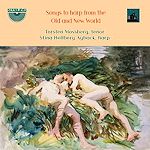A 336th Garland of British Light Music Composers
Most of our composers this time have been associated with writing for one instrument or type of instrument in particular. All come from the latter part of
the 20th century. To take the accordion first, Fred Bailey, active in the 1960s, was known for a few pieces for accordion band
such as the barcarolle The Gondolier. From the 1970s, we may point to Wilfred Walker, who published a Spanish dance, Playa Las Canteras (1971) and two Sonatinas, both for solo accordion, and Dennis Watson, whose Dance of the Penguins,
also for accordion solo, appeared in 1976.
Now for the single reeds, the clarinet and saxophone. Paul Carr composed during the 1980s Three Bagatelles and Dance Pieces for clarinet and piano (though he also published a few Impromptus for guitar solo and a Miniature Suite for two
guitars). Neil Garland, himself a clarinettist, lectured at one time at Huddersfield and formed a clarinet quartet of 3 B flats and one
bass clarinet called the Malton Ensemble which gave many concerts in the 1970s and subsequently he composed too, Five Times of Day, for clarinet
and piano, and Three Anagrams (entitled Lemons, Solemn and Melons!) which I heard performed in Doncaster by the Malton Ensemble – and
arranged widely, especially for the Malton. And during the 1970s Paul Arden-Taylor brought out many arrangements and published for
saxophone trio Bach goes to Sea (1976).
Keyboard composers can be represented by Bobby Fisher for his Royal Parade March (1981) and sundry classical arrangements, all
for organ, by Roger Hugh Pope, for Five Short Solos (1971) and Impressions (1974) for piano solo, and by the music
journalist Malcolm Macdonald (1916-) for his Entry of the Zanies, Mazwan Wedding and On the Avenue, all again
for piano solo, though Macdonald’s Cuban Rondo for clarinet and piano (or orchestra) may be his best remembered piece.
We end with the bassoon. Several composers for bassoon played it, like John Burness, composer of Four Easy Pieces and Five Day Week (1974), who published his memoirs, Bars Rest, in 1975, and Ian Kerrison, active in the 1950s, who
published in 1958 a Suite of Dances (Rigaudon, Sicilienne and Jig) and Three Young Pieces (Gremlin, Lullaby and, probably most popular amongst Kerrison’s output, The Fairy Clock), all for bassoon, plus Three Pieces for wind
trio. Also among composers for bassoon we may mention Geoffrey Hartley, for his two works for a trio of bassoons (without piano),Round the Mulberry Bush, A Fugal Trio (1974) and a Suite of 1976, and Peter Dodd for his Two Rhythmic Interludes (1964) for bassoon and piano.
Philip L Scowcroft
December 2002
A 337th Garland of British Light Music Composers
In these Garlands I have highlighted the work of many writers for young performers as their wares have to be tuneful, simple and readily accessible. One
not so far mentioned is Mary Hicks, active in the 1950s, whose works included some Nursery Rhymes arranged for piano duet, many
other arrangements, many unison or other songs for schoolchildren of which we may exemplify Ducks’ Ditty (whose lyric comes of course from The Wind in the Willows), The Cloud House and The Two Mice and, for piano solo, Reflections: Six Short Pieces.
Sidonie Goossens
was one of two harpist sisters from a famous family of Belgian extraction who illuminated British music for several generations. Born in 1899, she studied
at the Royal Academy of Music, played for many years in the BBC Symphony Orchestra and became a Professor of the Harp at the Guildhall School. She composed
for harp and earns a mention here primarily for a very brief Interlude used regularly in BBC Radio’s serial Mrs Dale’s Diary.
Arthur Graham
merits notice for his march The Champion, whose date I do not precisely know but was probably some time in the 1920s, as does Sarah Class, for her music for TV, most recently for Dogfight (2002) in Channel 4’s Secret History series.
And so finally to Joseph Ascher (1829-69), resident for much of his short life in this country, concert pianist and composer, most notably
of the still popular ballad Alice where art thou? and of much instrumental music such as the Bravura Galop, La Source Limpide,Chasse aux Papillons, Mazur des Traineux, and fantasies for piano on Rule Britannia and on the Danish National Anthem, King Christian.
Philip L Scowcroft
December 2002










